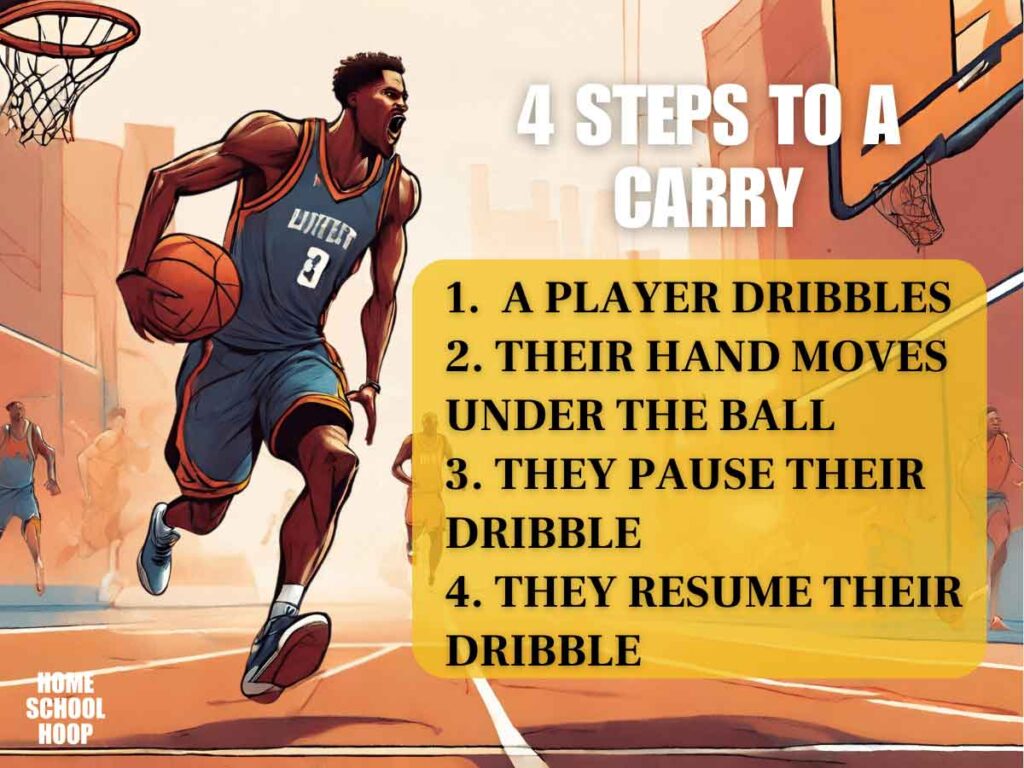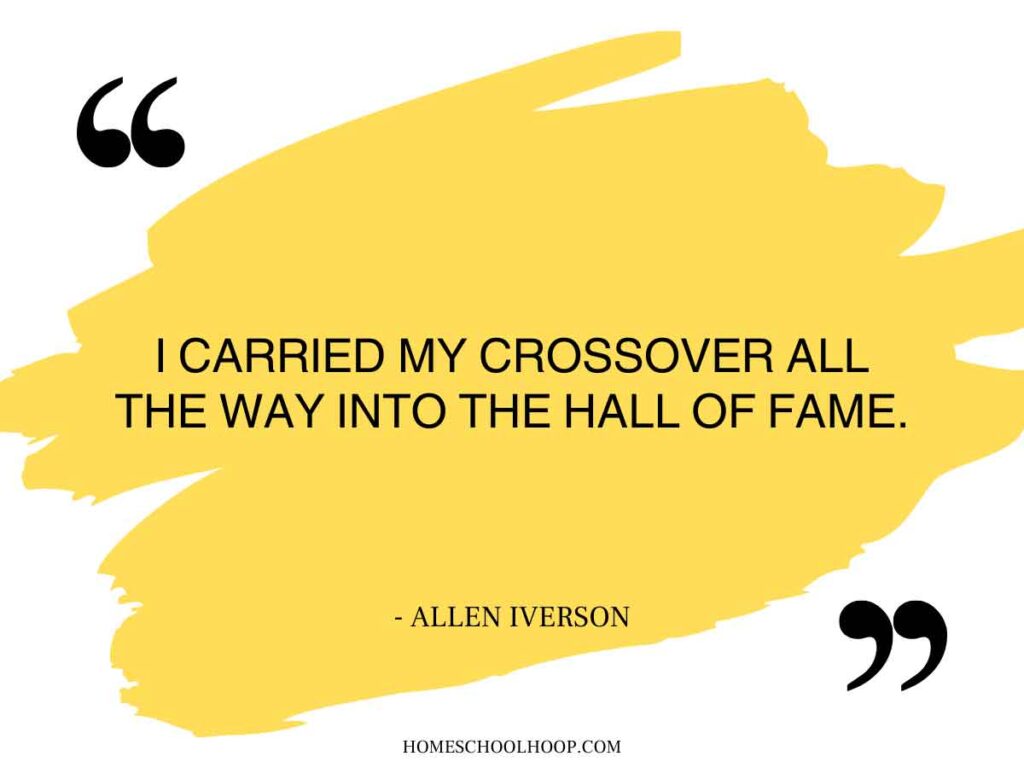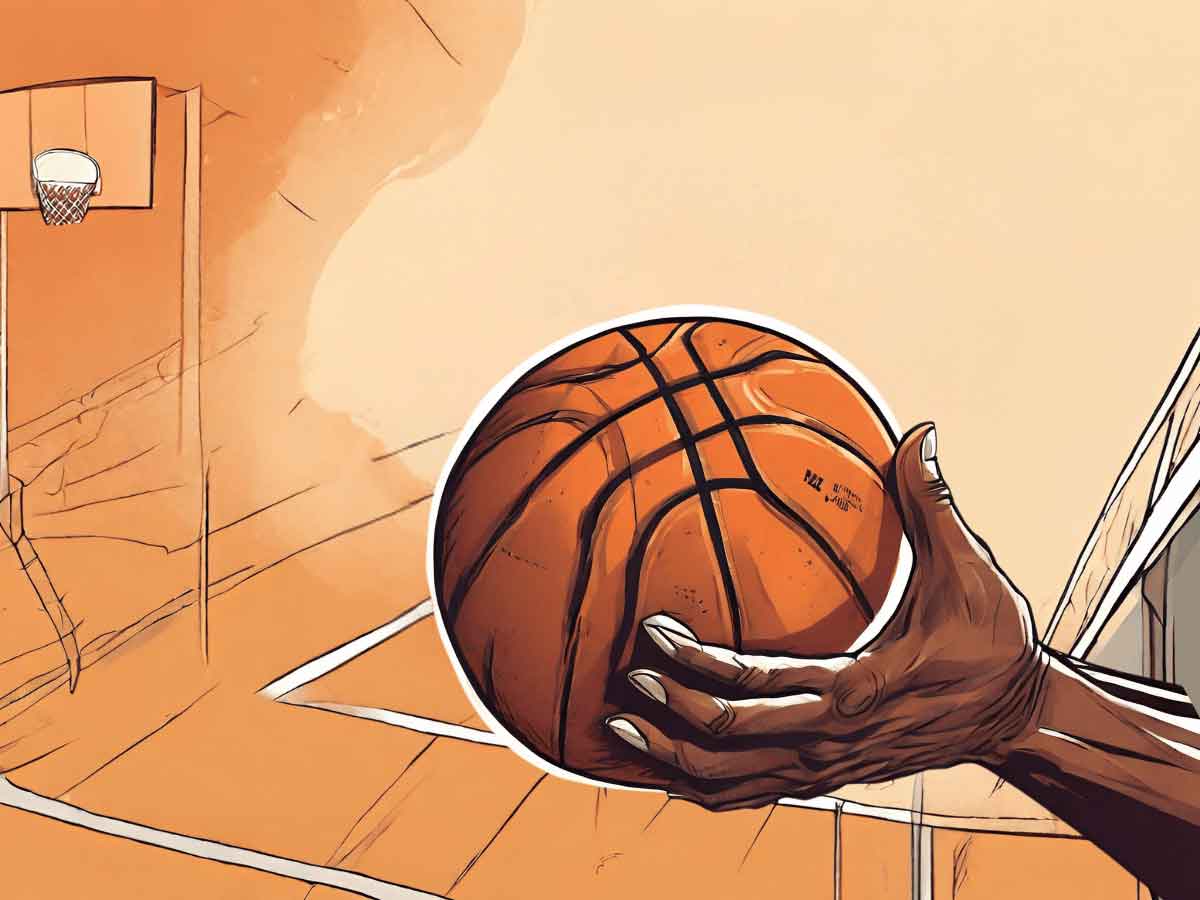Ball-handling skills are valuable as a basketball player because they help you move past defenders and set up plays. But, sometimes, players struggle to keep control under pressure. One common mistake is a carry in basketball, also known as palming.
Key Takeaways:
- A carry in basketball is a violation involving improper dribbling, where the player’s hand rests underneath the ball.
- Getting called for a carry results in a turnover, giving the possession of the ball to the other team.
- This rule applies at all levels of basketball, including the NBA, WNBA, college, and high school leagues.
Understanding what counts as a carry can be tricky. We’re going to explain how a carry happens, how it’s spotted and penalized by referees, and share advice on how players can avoid this frequent mistake.
Definition of a Carry
A carry in basketball is an illegal move that happens during dribbling. When a player is carrying, or palming, it means they’ve momentarily stopped dribbling by letting the ball rest in their hand or by flipping the ball over with their hand underneath it.
This error is common during hesitation moves or when a player is trying to dodge an opponent. The main thing to look out for to spot a carry is whether the player’s hand ends up below the ball while dribbling, which is not allowed.
Carry vs. Travel in Basketball
Carrying and traveling in basketball are two types of dribbling mistakes that often get mixed up, but they refer to different actions:
Carry:
- This involves the hand going underneath the ball and pausing the dribble. It’s something you might see when a player is doing a fancy dribble or hesitating.
Travel:
- This happens when a player takes more than the allowed steps without dribbling or moves their pivot foot after it’s been set.
Carry vs. Double Dribble
Another violation similar to carrying in basketball is the double dribble. But the two dribbling violations are not the same:
Carry:
- This violation focuses on the hand’s position under the ball and stopping the dribble temporarily.
Double Dribble:
- This occurs when a player starts dribbling again after having stopped and held the ball with both hands or dribbles with both hands simultaneously.
TRIVIA: Can You Guess the Player?
This NBA legend is often credited with pushing the boundaries of what is considered a carry in basketball. His signature crossover move left defenders in the dust and changed how the game is played, even though it stretched the carry rules.
Clue 1: He was the first overall pick in the 1996 NBA Draft.
Clue 2: Known for his scoring abilities, he won the NBA scoring title four times.
Clue 3: Famously said, “Practice? We’re talking about practice,” during a press conference.
Scroll to the bottom for the answer.
How a Carry in Basketball Occurs
A carry in basketball is a mistake that breaks dribbling rules. Let’s walk through the steps that lead to this violation:
- A Player Dribbles: A player starts dribbling by bouncing the ball on the court, keeping their hand on top of the ball to push it down.
- Hand Moves Under the Ball: During the dribble, the player’s hand might slip under the ball. This often happens during quick direction changes or hesitations to throw the defense off balance.
- Dribble Pauses: When the player’s hand ends up under the ball and stops its bounce, even for a second, it’s considered a pause in the dribble, which is against the rules.
- Resuming the Dribble: The player then keeps dribbling as if they hadn’t stopped, leading to what’s known as a carry.

What to Keep in Mind:
- To dribble correctly, a player’s hand should always be on top or at the side of the ball.
- Any time the hand supports the ball from underneath and the dribble resumes, it’s considered a carry.
- This error can occur both in quick gameplay and while performing complex dribbling maneuvers.
Rules on Carrying
Carrying in basketball is a violation across the various basketball leagues, from the NBA, WNBA, NCAA, and high school basketball. How the leagues differ is how strictly they enforce the rule.
The NBA tends to be more lenient in calling dribbling violations, favoring offensive play to keep the game fast-paced and exciting. Meanwhile, the NCAA and high schools enforce the carry rule more stringently. This stricter approach aims to teach young players proper dribbling techniques and uphold the integrity of amateur basketball.
NBA and WNBA Rules on Carrying
Both the NBA and WNBA rule books share the same definition of carrying:
“A player who is dribbling may not put any part of his hand (NBA) / her hand (WNBA) under the ball and (1) carry it from one point to another or (2) bring it to a pause and then continue to dribble again.”
NCAA Rules on Carrying
The NCAA rules on carrying are similar to those in the NBA and WNBA but are enforced more strictly. The focus is on ensuring players dribble consistently, without letting their hand slide under the ball.
High School Rules on Carrying
Similar to the NCAA, high school basketball emphasizes dribbling fundamentals, closely monitoring carrying violations to instill proper techniques from the start.
Penalties for Carrying
When a player gets called for a carry violation, it stops the game and shifts possession. Here’s what happens:
- Stoppage of play: Play is stopped momentarily when a carry is called. The referee blows their while and signals the carry violation with their hand.
- Turnover: The primary penalty for carrying is a turnover. The player’s team loses possession, and the ball is given to the opposing team as a throw-in opportunity.
Carrying violations, like any turnover in basketball, can shift the game’s momentum. They crush a team’s offensive rhythm in its tracks, leading to frustration and potentially more errors. And of course, the opposing team gets the opportunity to capitalize on the mistake and additional possession.

How to Avoid Carrying Violations
Carry calls don’t happen very often, but they’re something that needs to be addressed if you find you’re getting them regularly. Here are some tips for players to dribble without carrying the ball:
- Keep Your Hand on Top or Side of the Ball: This prevents your hand from going underneath the ball, which is considered a carry in basketball.
- Focus on Ball Control: Practice dribbling drills that put you in a position when carries most often occur (hesitations and crossovers) so you can master these moves without the violation.
- Practice Under Pressure: Practice dribbling with someone defending you. This prepares you to maintain a legal dribble even in challenging game situations.
FAQs
What defines a carry in basketball?
A carry in basketball occurs when a dribbling player places their hand underneath the ball to pause before starting again.
What is the NBA carry rule?
The NBA carry rule states that a player cannot put their hand under the ball while dribbling to carry it from one point to another or pause and then resume dribbling.
Is a high dribble a carry?
A high dribble is not necessarily a carry. A carry involves the hand going under the ball during the dribble. As long as the hand stays on top or to the side of the ball, even in a high dribble, it’s not considered a carry.
What is the difference between a travel and a carry?
A travel involves taking too many steps without dribbling the ball, while a carry involves improper hand placement under the ball during a dribble. Both are violations, but they involve different actions and rules.
Is double dribble a carry?
No, a double dribble is not a carry. A double dribble occurs when a player stops dribbling, holds the ball, and then starts dribbling again or dribbles with both hands. A carry specifically involves the hand placement under the ball during a single dribble motion.
Is carrying in basketball ever legal?
No, carrying is always considered a violation in basketball. However, referees in some leagues are more lenient with calling it.
LET US KNOW
Today, you learned about the carry in basketball.
So we want to know: Do you think the NBA and WNBA should enforce the carry rule more strictly, or do you appreciate the flexibility in today’s game that allows for more creativity and flair?
Let us know in the comments.
The TRIVIA answer is Allen Iverson.



